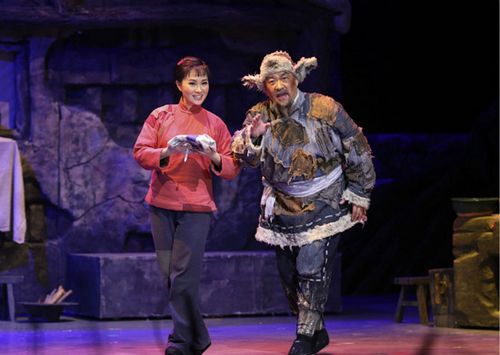
In the evening of November 6, the Ministry of Culture of People's Republic of China launched a national tour of the classical opera, White Haired Girl, based on a legendary Chinese folk tale.
The heroine, a "White haired girl", is named Xi'er, daughter of Yang Bailao, a poor old tenant farmer.
Under persecution of the landlord, Huang Shiren, Xi'er was forced to separate with her sweetheart Dachun. Hiding in a cave, Xi'er suffered much sorrow and her hair turned white.
Later, the Communist Party launched a people's fight against the oppression of landlords. Huang Shiren was eradicated, and the "white haired girl" got saved. She returned to Dachun and got married, as her hair turned from white to black again.
In 1945, White Haired Girl premiered in Yan'an, a revolutionary base in northwest China, causing a sensation.
For over 70 years, White Haired Girl is recognized as one of the national opera classics, depicted in many art forms such as stage plays including dance drama and ballet and films, which have an enduring appeal for audiences.
Peng Liyuan, dean of the Art Institute of the Chinese People's Liberation Army, served as artistic director of the new version of "White Haired Girl."
While retaining the original classic quality, the new version combined characteristics of the times and features of the actors and actresses, so the opera can meet the aesthetic needs of a modern audience.
Compared with 70 years ago, China has undergone tremendous changes. The Chinese are now enjoying enormous material and spiritual wealth.
China is maturing as the world's second largest economy, while still cherishing folk arts in Chinese classics.
As a saying goes, what belongs to the nation belongs to the world. The classic meaning of White Haired Girl is reflected in its combination of nationality and cosmopolitan themes.
White Haired Girl has eternal value.
The story of Xi'er conveys the Chinese pursuit of liberation and true love, along with their struggle against injustice. It holds the mainstream values narrated by modern Chinese history and also common values reflecting by humanism.
The tale has attracted great resonance for different cultural backgrounds.
White Haired Girl has impressive artistic charms.
The image Xi'er originates from Chinese folk tales, but adopted into a foreign art form — opera. Western opera emphasizes singing, however, the Chinese national opera utilizes stage "gestures, eye expressions, body postures, stage walks, and performing principles" from traditional Chinese operas.
The new edition returns to the opera art ontology, highlighting music. The story gives prominence to Shanbei and Shanxi folk music elements in northwest China, fusing a unique Chinese style.
White Haired Girl has historical heritage with warmth.
From Wang Kun, the first generation of the "white haired girl", Guo Lanying, the second generation, and Peng Liyuan, the third, to Lei Jia, the most recent, "white haired girl", the "passing down of the art torch" has been reflected.
Through unremitting efforts, generations of Chinese artists have created an art classic in a new era. People can feel the warmth of the opera and appreciate the unique charms of Chinese culture.
As an immortal memory of modern Chinese history, the White Haired Girl is a timeless tale showcasing the national spirit. It deserves profound study from Chinese and world artists.
The author Hu Yifeng is Research Branch Director at Chinese Literary Critics Association, and Director at Chinese Literature Association and Art Review Center.